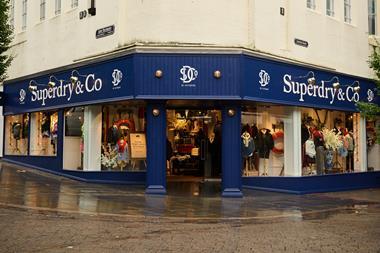Boots sees partnerships with other retailers as key to its future growth. Three years on from Stefano Pessina’s takeover, Jennifer Creevy visits its Nottingham HQ

Boots is one of the strongest brands in UK retail but the health and beauty giant increasingly sees partnerships as a key part of its future.
On Tuesday, the pharmacy group unveiled a deal with maternity specialist Mothercare under which Boots will exclusively sell a new children’s clothing and accessories brand jointly designed, sourced and supplied.
Partnerships in the UK, along with international growth, will help Boots, which has 2,600 UK stores, extend its reach in a competitive environment says Alex Gourlay, chief executive of Alliance Boots’ health and beauty division.
Alliance Boots executive chairman Stefano Pessina has previously told Retail Week that rather than open more shops in the UK, the retailer will forge partnerships to grow share.
The Mothercare deal builds on an existing partnership whereby Boots sells Mothercare’s Early Learning Centre toys in more than 400 shops. Until now, Boots has stocked Adams’ Mini Mode range.
Boots’ partnership with John Lewis-owned grocer Waitrose will also bear fruit this year, about which Boots has been tight-lipped until now. Boots has already rebranded the 13 pharmacies it operates in Waitrose stores. Retail Week can reveal this will be followed by three trials - Boots health and beauty products to be sold in Waitrose, four 1,615 sq ft to 2,150 sq ft Waitrose shop-in-shops in Boots, and Boots lunchtime sandwiches to be switched with Waitrose products.
“The cultures of Waitrose and Boots are very similar and have a similar sense in quality and value,” says Gourlay.
Boots is also mulling partnerships for its online operation. The retailer has operated a click-and-collect service for just over a year and at Christmas 40% of online orders were collected in stores.
Boots hopes in future to develop click-and-collect partnerships with other retailers, enabling customers to pick up products from non-competitive retailers from Boots stores - a move that will “drive footfall” to the high streets, says Gourlay.
Boots director of multichannel Tim Stacey says store staff have already got behind click-and-collect because the online sales are credited to the store, which he says “makes it much easier for us to operate a joined-up operation”.
The website will also be developed further this year on both the health and beauty sides. Last year Boots launched a health information website in conjunction with US giant WebMD and Stacey says this deal “has given us authority in health”.
Such partnerships give Boots an advantage in a market in which the grocers are powerful competitors. Gourlay observes that “grocers are still taking share from the high street and we are showing good gains in our categories so everyone else must be suffering”.
Gourlay admits: “I love Tesco and I hate it because it’s a great business model and offers convenience across most categories but it provides tough competition for everyone else.”
New ways of doing things have become characteristic of Boots, which was acquired by private equity fund KKR in 2007 in an £11.1bn deal headed by Italian billionaire Pessina. The retailer has transformed its operations in an attempt to become the world’s leading pharmacy-led health and beauty retailer.
A proud legac Boots is one of the most venerable companies in retail and its UK head office - set in 300 acres and comprising a sprawling campus of buildings all with the prefix D in reference to the Dunkirk, Nottingham, area in which it is set - befits that reputation.
And although change is very much part of business, Gourlay believes Boots’ history is vital to its appeal. He says Boots was “probably the first national retailer” and “is unique in that we have our manufacturing, supply chain and head office at one site”.
The site, with a Grade II listed head office, is a mix of old and new. Original oak panels line what was the executive offices, and artefacts from the early chemists’ shops adorn the corridors.
Gourlay says: “Our history gives us a great legacy and one that we can build on. And while we are respectful of our past, our focus since 2007 has been to set the company up for future growth.”
Boots is already reaping the rewards of its transformation. Over Christmas UK retail like-for-like sales were up 4.6%. “We have a strong momentum,” says Gourlay. “And while the year ahead will remain tough, we feel confident about our position.”
Since 2007, Boots’ transformation has included overhauling the supply chain, implementing a more customer-led service proposition, rebranding more than 1,000 pharmacies and investing more in product development.
“We’ve been through some massive changes,” says Gourlay. “There has been a lot of disruption but it has made us stronger and ready for the next phase.”
He explains that while some of the changes have been difficult for staff - most recently including the proposal laid out last month that Alliance Boots will close its final-salary pension - they are essential for future growth.
He says: “I’ve been in the company long enough to remember when we were knocking ideas away and it didn’t feel very good. Now we’re not in a defensive mood and the feeling is much more positive and healthy.”
There is plenty still to do. Stacey says there is further scope to offer personalised health services and to encourage online communities. Boots is working on the launch of a social networking site for its Parenting Club, which already offers special deals for Advantage Card users with children.
“We want to build a community for parents to share tips and information and encourage interaction with the brand,” says Stacey. “We see scope for other communities down the line.”
Boots will also invest in technology to centralise its Advantage Card database, and is considering opening its loyalty scheme to other partners.
All in the brand
Late last year Boots completed two monumental projects - the rebranding of 1,000 pharmacies and the establishment of its stores service centre (SSC).
Following the merger with Alliance UniChem in 2006, Boots set out to rebrand the UniChem pharmacies to Your Local Boots Pharmacy.
Boots UK director of store implementation Peter Wright explains Boots never closed the NHS dispensing service throughout the rebranding, which typically lasted from Saturday evening through to Monday or Tuesday.
The pharmacies were given new systems, some had facilities upgraded, and all had some Boots products installed. “What we made clear from the start was that the teams in the stores would remain the same and we told customers that from the outset,” Wright says.
Boots rebranded the pharmacies at a rate of 30 to 40 a month peaking at over 100 shops last October, and reopening launches were organised at store manager level.
Wright says customers have been “delighted” with the range of Boots products in their local shops, and click-and-collect helps because “it’s like having the whole of Meadowhall in the stock room”.
The new supply chain was no mean feat. Previously, Boots operated four central and 17 regional warehouses and the new on-site SSC - comprising 975,000 sq ft - now does the same job.
The changes meant 2,000 staff left the business last year, but supply chain director Deirdre Burns says workers were given three years’ notice and training courses and help was on offer for those affected.
Shifts in working patterns also affected the warehouse staff, with some of the problems still being worked through. Boots has an open-door policy to any issues in the distribution centres with posters dotted around the sites with engagement scores, any issues the changes have thrown up, and an “emotion tree” for ideas on how to make their working lives better.
“It’s a huge shift for people who have worked the same hours for years to suddenly have to change,” says Gourlay. “The benefits to the business are huge but we know readjustment takes time.”
The SSC has already “exceeded expectations” with 98% availability over Christmas.
The enquiries call centre has also been centralised, having previously been linked with shops. All enquiries are now fed through including Advantage Card questions, Boots.com enquiries and opticians bookings.
Boots also reshuffled its store portfolio to a format-led business, and over the past two years has linked bonuses and rewards with customer care. It also switched its mystery shopper research to customer research where feedback is invited via till receipts.
Stores director Simon Roberts says Boots aims to be “the number one retailer in customer service”. He says: “Like-for-like sales are important, but there is now a shift whereby staff look at the customer care numbers before the sales numbers.” He also adds that “the right store manager can make a 10% difference in like-for-like sales”.
Product development has also been stepped up. Boots has always had a strong history of product development and its team developed Ibuprofen in 1969, and some own-brands such as Soltan and No7 go back to the 1930s.
No7 Protect & Perfect has been one of the recent outstanding stars. And part of its success is down to the teams working with independent bodies for product testing, and working closely with the marketing team.
The brand’s hit on TV show Horizon led to shelves being cleared of Protect & Perfect in 2008 and the range has since been expanded. It has since gained further popularity due to an independent study by the University of Manchester.
Steph Franklin, product bank formulation manager, says Boots is unique in that “we can get products to market quickly because we control manufacturing, packaging, marketing and have the retail stores”. The challenge now, she says, is to raise the bar again as “Stefano wants every launch to be like Protect & Perfect now”.
Contrary to what some may have expected at the time of the takeover, there is new life in the retailer - despite some of the inevitable changes. The campus may be steeped in history but Boots is shaping its business to secure its place in the future.


























No comments yet